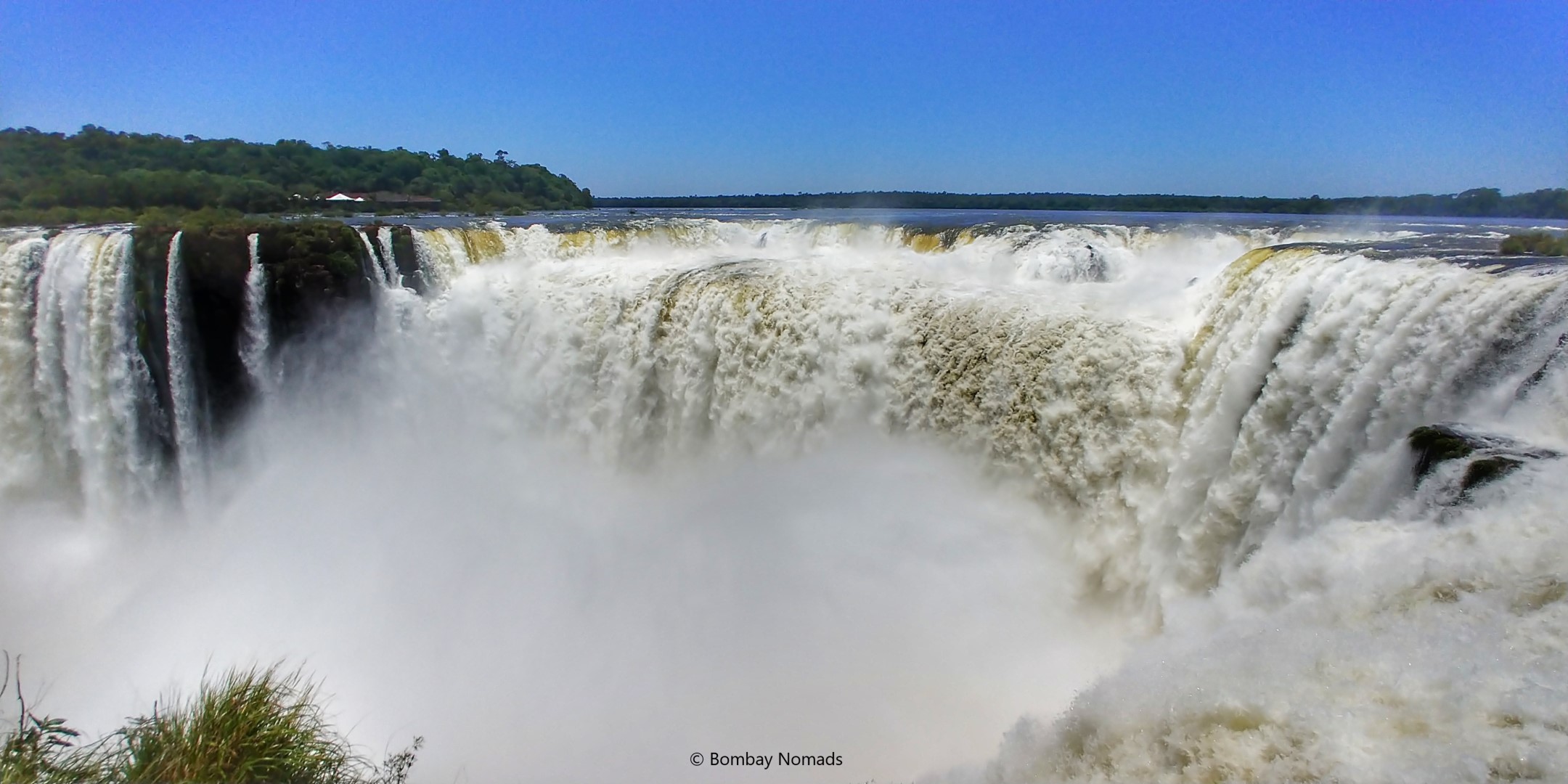Iguazu Falls are one of the most dramatic and monumental natural wonders in this world. At double the height and three times the width of Niagara Falls, it will turn the most jaded of travelers into excited children. You may have seen all the photos before, but nothing prepares you for the moment when you come face to face with the Devil’s Throat waterfall and watch the gigantic wall of water fall into the mist below.
The falls and the Iguazu river form the border between Brazil and Argentina and can be visited from both countries. The base for visiting Iguazu falls on the Argentine side is Puerto Iguazu and on the Brazilain side it is Foz do Iguaçu. You can make either one of the towns your base and visit both sides (taxi ride between the two sides is ~45 mins).
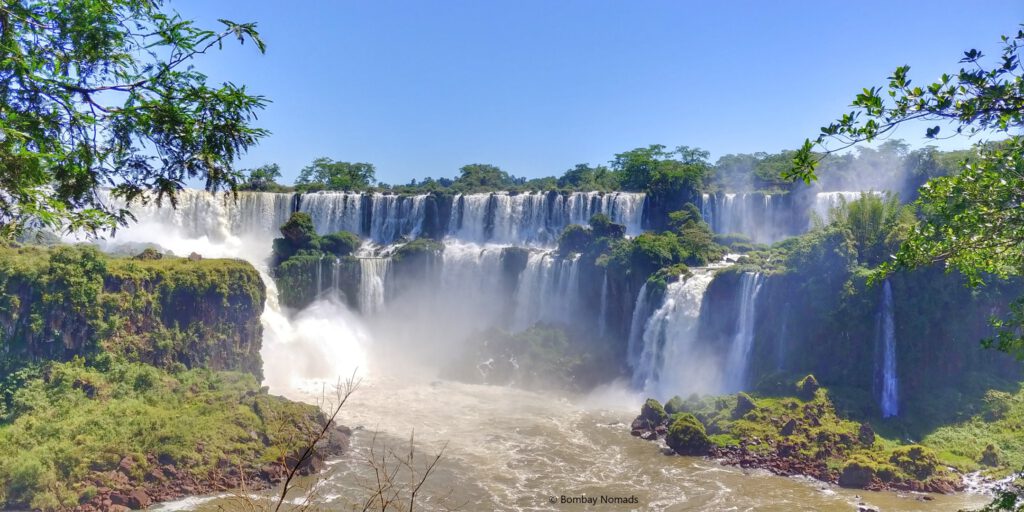
We did not have a Brazilian visa, so our visit was limited to the Argentine side. From what we have read, the Argentine side has better tourist infrastructure – there are kilometres of trails laid out, which allow tourists to go very close to the waterfalls. If you have the time, the budget and visas, you should definitely visit both sides. But if you don’t have the time for both, we would recommend choosing the Argentine side.
Day 1:
We reached Puerto Iguazu via an early morning flight from Buenos Aires, landing at about 08:20. We were staying for two days at the Grand Crucero Hotel in Puerto Iguazu. The taxi from airport to hotel cost us 700 pesos. (1 USD = 37 Argentine Pesos, when we were there)
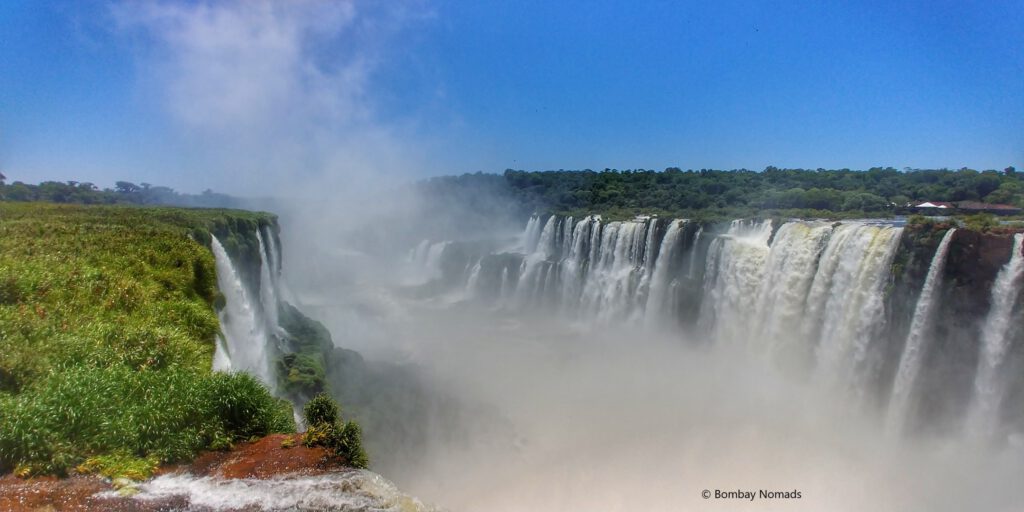
The hotel, turned out to be a delight – they allowed us to take the breakfast on that day, in lieu of our breakfast on the last day, when we had an early morning flight. And by the time we finished breakfast (around 10:00), we were offered our room (3-4 hours before usual check-in time). The room was a good size, well-furnished and spotless. And it also had a satisfying rain-type shower.
The waterfalls are surrounded by dense evergreen jungle of Iguazu National Park. The taxi to the park entrance costs 700 pesos too – the park and airport are close to each other and equidistant from the town. The bus company Rio Uruguay runs buses every 20 minutes from the town to the park, which costs only 130 pesos per head. The bus starts from the town centre and conveniently there was a stop right next to our hotel.
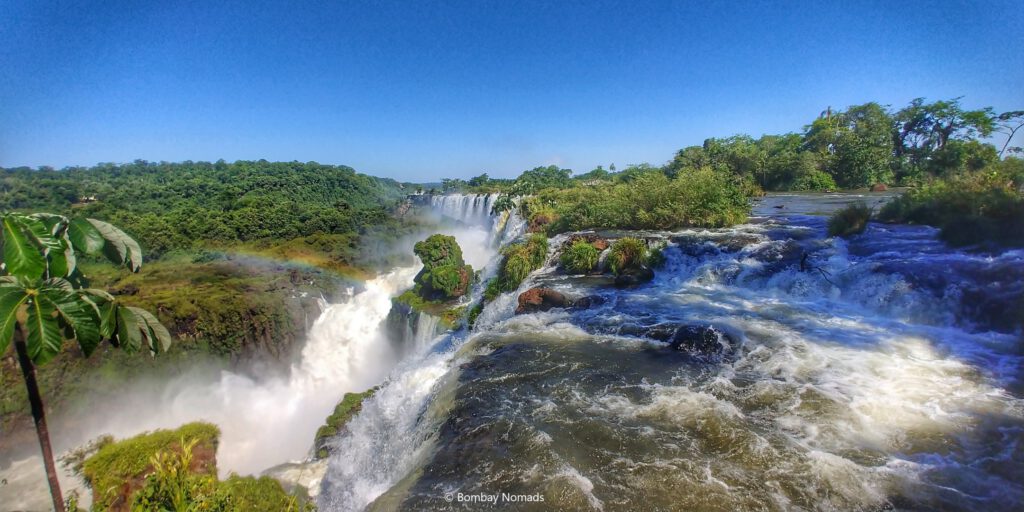
We were waiting at the bus stop, when we were approached by an enterprising taxi driver who offered to drop us to the park for 400 pesos. We gladly took up the offer, as the sun was out strongly, and it felt much hotter than the 25 deg C that Accuweather was telling us.
Buying tickets to the park were a breeze because we were well past the opening rush (park opens at 08:00). Entrance ticket to this UNESCO World Heritage site costs 700 pesos per person for foreign nationals. Inside the park there is a toy train (narrow gauge) that takes you to the start of different trails. The train is free to use and there are 3 trails inside the park.
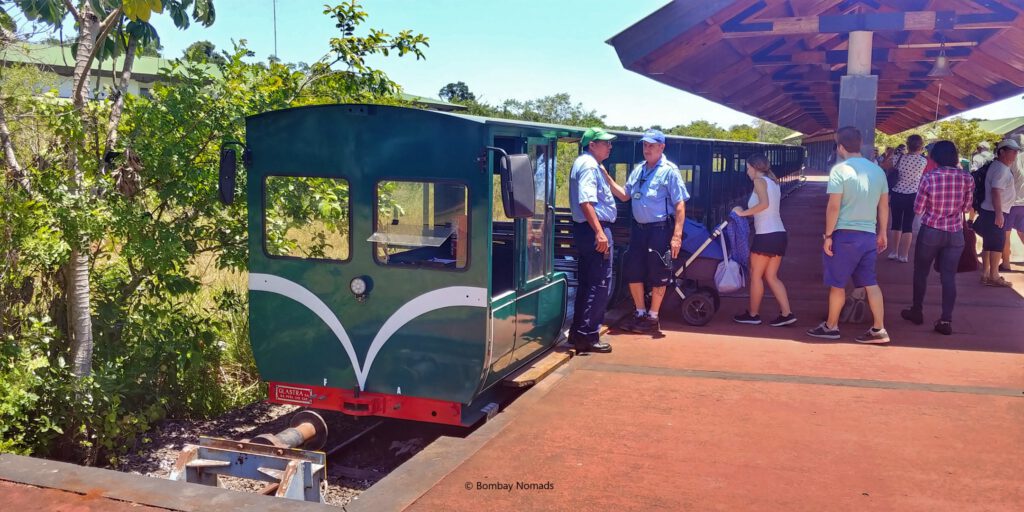
- The Lower Circuit
- The Upper Circuit
- The Devil’s Throat
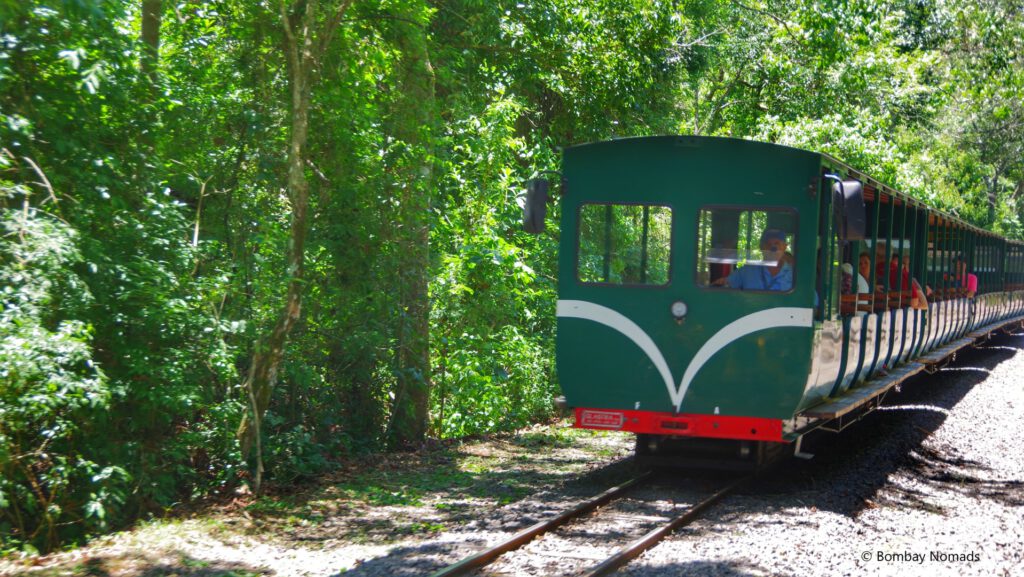
The Upper Circuit is called Circuito Superior and Lower Circuit is called Circuito Inferior, but do not let the names mislead you – in Spanish they just mean upper and lower, respectively.
Both the upper and lower circuits are served by the first stop of the train – the Cataratas station. The second stop is for the Devil’s Throat. However, not all trains stop at Cataratas station – something we found out the wrong way. We wanted to do the upper/lower circuits first, but found ourselves on the other train, though it doesn’t really matter which trail you do first.
Tip : There are no displays or announcements for the trains. Better to ask one of the staff if a particular train goes to Cataratas station.
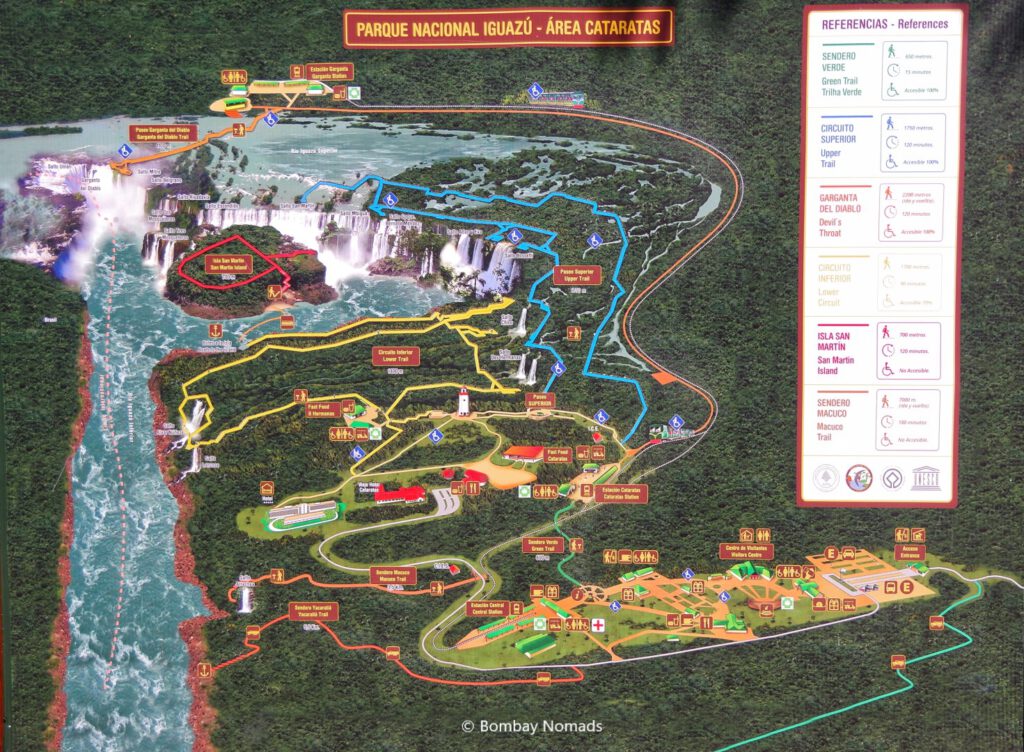
In terms of wow factor, the Devil’s Throat will take your breath away with the sheer power and scale of the waterfalls. That was our first sight of the falls and we were absolutely unprepared for what we saw. It was almost hypnotic and we just stood and stared for a long time, speechless.
The other two circuits let you approach different cascades of the waterfalls via some wonderful walking trails. Iguazu is composed of 150-300 individual waterfalls, and these trails have several viewpoints. Our personal favourite was one of the spots on the Lower Circuit, where the trail almost goes under a waterfall. You get drenched with a wonderful mist and it is impossible to visit and not have a big grin plastered on your face!
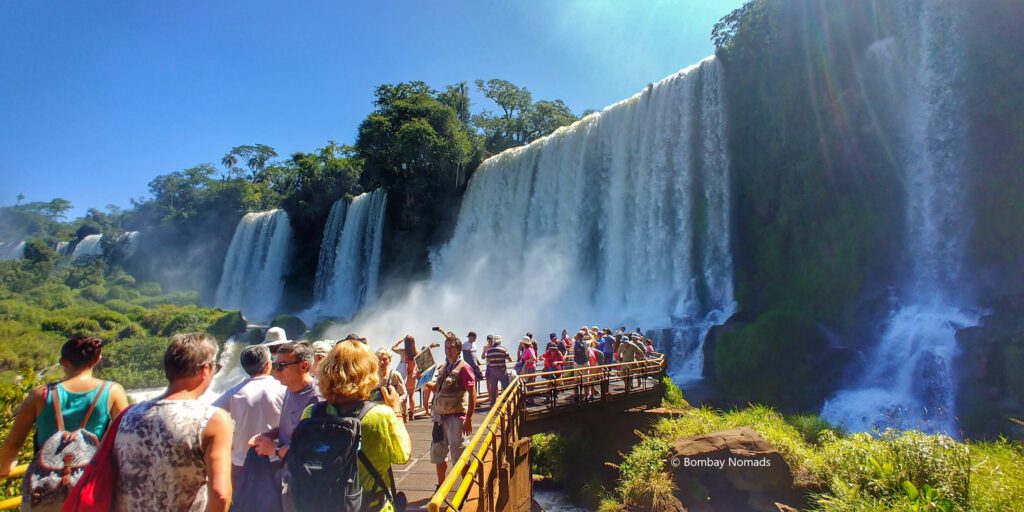
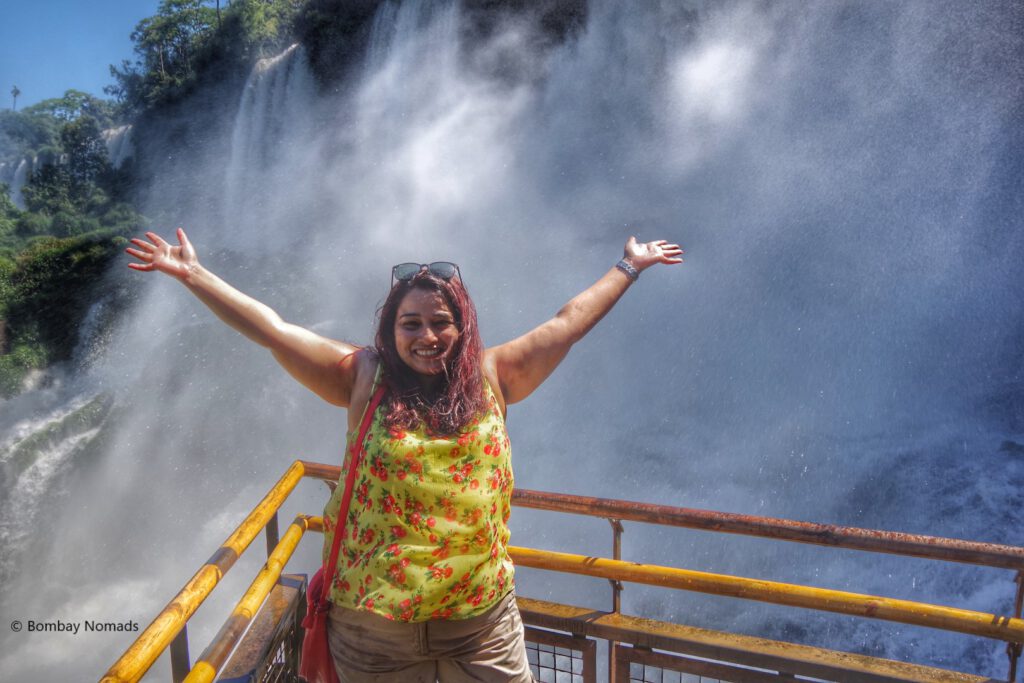
We are relatively unfit, and we took 75 min for the lower circuit, 45 minutes for the upper circuit and 45 minutes for the Devil’s Throat. That included a lot of stops for photos and just staring at the falls (but excludes time spent on the train or waiting for the train). So, it is easily possible to do all three circuits in a single day. In terms of walking distance, the Devil’s Throat has the least amount of walking and it also does not have any stairs. The other two trails have quite a few stairs to navigate. The train itself is very slow and takes time. Also, be prepared for some waiting time as the frequency of trains is not all that good.
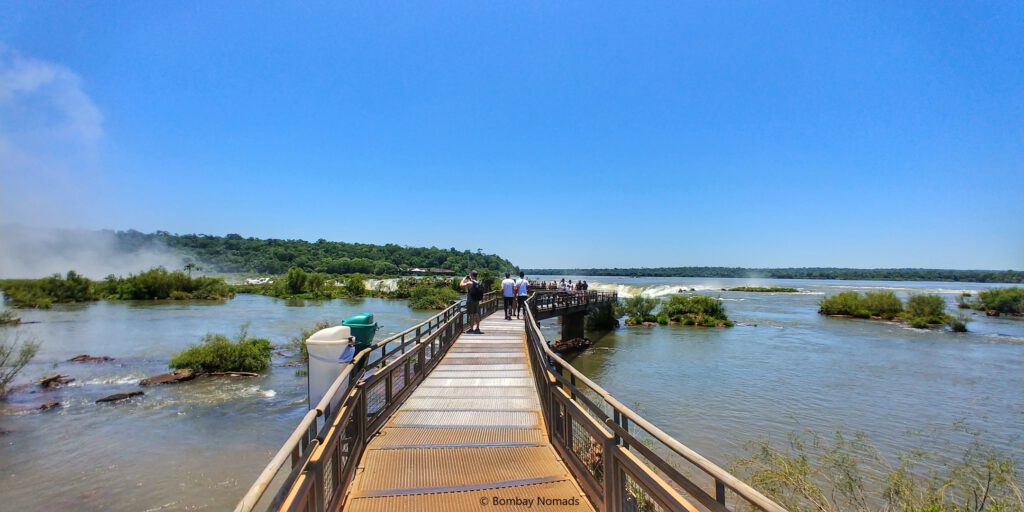
There are enough refreshment stops inside the park, especially at the train stations. They mostly serve sandwiches, empanadas and packaged snacks. We grabbed a quick lunch in one of the train stations.
Tip : A warning regarding the Coati. Coati are these cute raccoon-like animals, that are a fairly common sight in Iguazu National Park, especially near the food stalls. However, they will snatch any food that they can see, like monkeys in India. They have long claws and they can bite – and are known to carry rabies. There are warnings posted throughout the park, with graphic photos of wounds after a coati attack. We witnessed coatis snatching food from unsuspecting tourists on 3-4 separate occasions – and they are fearless enough to attack a tourist standing in a queue of 20-30 people.

Apart from the three trails, the boat ride under the waterfalls is highly recommended. On the Argentine side, the company offering the boat ride is called Iguazu Jungle ( http://www.iguazujungle.com/eng/ ). The ride cost us 2,000 pesos per person and can be booked inside the park, next to the information centre (Look for the guys with yellow t-shirts inside the park). Tickets can be booked online as well, but apparently they are usually easily available on the spot. However, when we tried to book our tickets, we were told most of the slots of the day were full, and the only options were right then, or next day morning at 09:30. We chose next day because we weren’t mentally prepared to be dunked under water right then.
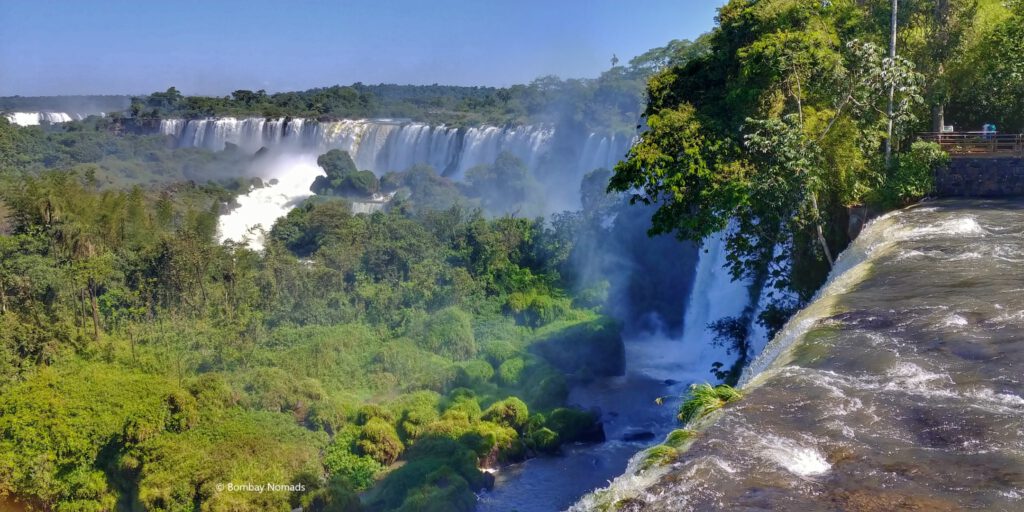
If you reach the park at 08:00, you should be able to do all three trails AND the boat ride on the same day. However, for whatever reason, if you are short on time, we would recommend skipping the Upper Circuit and doing the other two trails along with the boat ride.
After visiting all three circuits on Day 1, we took the Rio Uruguay bus back to our hotel.
Tip: If you are in the park for more than 1 day, make sure you get the ticket of day 1 validated at the ticket counter on your way out. Carry that ticket from day 1 on the second (consecutive) day and you are eligible for 50% discount.
Day 2:
A lot of people who visit Iguazu falls, use the second day to view the Brazilian side of the falls. Since we did not have Brazilian visa, for day two we had only the boat ride on our itinerary.
Just like the day before, we found another enterprising taxi driver to took us to the park, for 500 pesos, shared between 3 passengers. There was a queue in the morning, but it wasn’t too bad, and we got 50% off because we had kept the previous day’s tickets.
The boat ride “adventure” lasts about 2 hours, out of which the boat ride itself is not even 30 minutes. We were put on an open roof bus and sent to the dock via a 30-minute jungle ride. The guide gave some information about conservation efforts of the forest and the history of the falls, but there is nothing much to be seen. Once at the docks, everyone was given a life jacket and a dry bag to keep valuables dry. These dry bags are the ones used while kayaking/rafting, so they are quite waterproof and were also large enough to swallow a 20L backpack+ shoes. The boat was decent sized and could seat all the 25-30 passengers of our bus together.
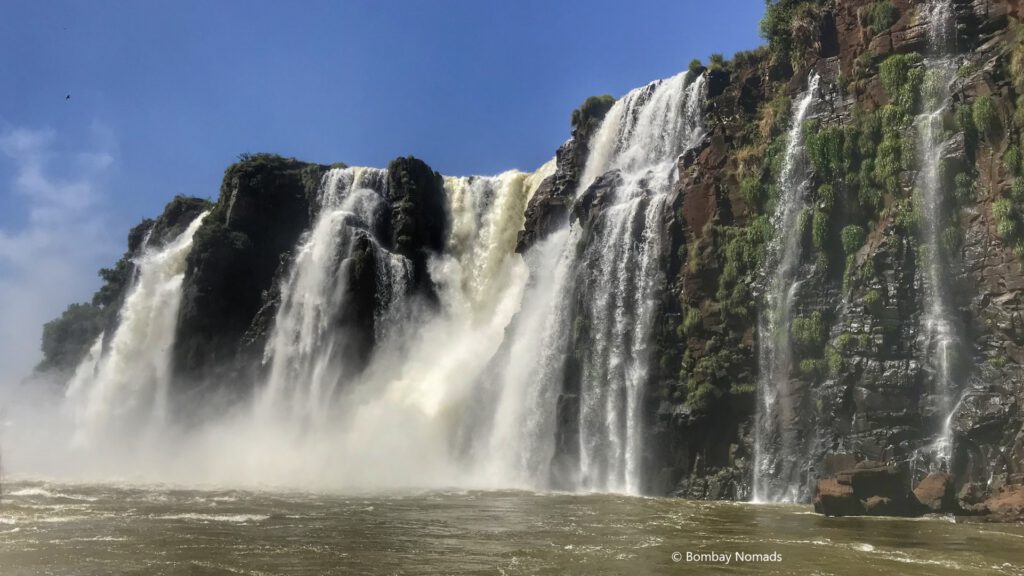
The boat then raced towards the falls, and the ride was fun, on the slightly choppy river. The pilot first took us close to the waterfalls and held the boat there, so that we could take photos without getting wet. Once that is done, we were told to secure our phones/cameras in the dry bag before taking us for a shower under the falls. Going under the falls was CRAZY FUN and gigantic torrents of water soaked us completely. Ponchos, rain jackets etc stood no chance against that downpour.
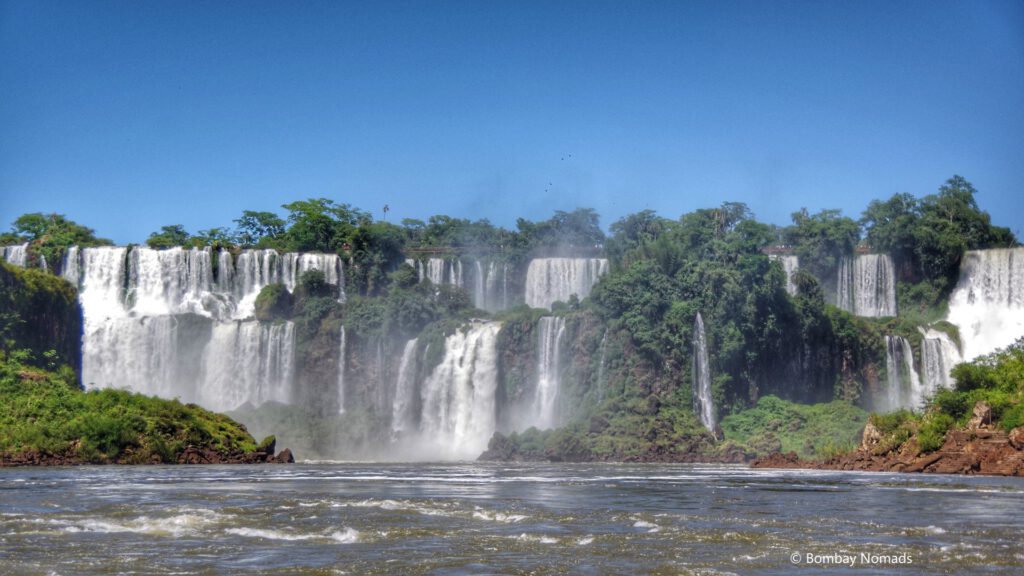
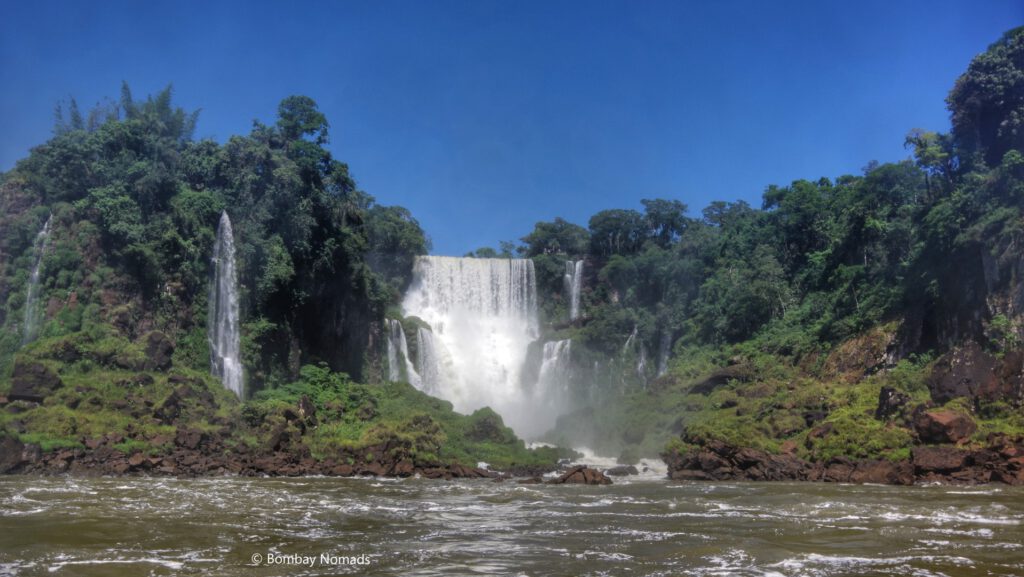
(I had bravely kept my Pentax “waterproof DSLR” inside my plastic poncho, and it was completely soaked like the rest of me – but I am glad to report that Pentax products live up to their claim)
We were anyway going back to the hotel after the boat ride, so we didn’t mind getting drenched. Iguazu has sunny tropical weather so even if you are drenched, you will get relatively dry after a couple of hours of walking around.
Tip: You can carry a change of clothes or strip to your swimsuit once you are on the boat, like a lot of our fellow travellers. However, be prepared for long queues to change, as there was only one toilet each, for males and females.
After the boat ride, the open bus took the same jungle route back and dropped us off close to Cataratas station, where we took the train back to the main station. On our walk back to the exit, we saw beautiful toucans on trees near the information centre, along with lots of weaver bird nests.
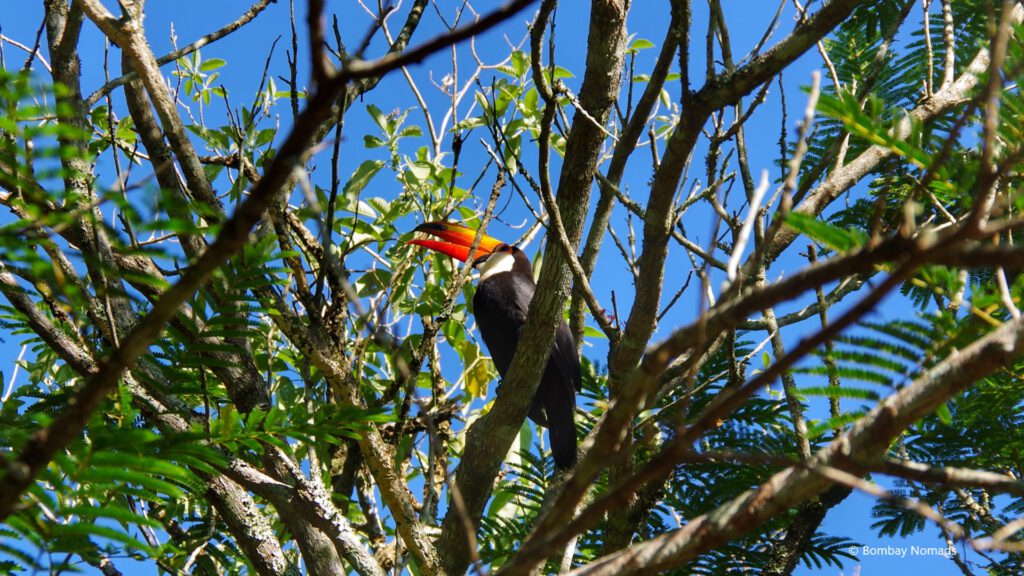
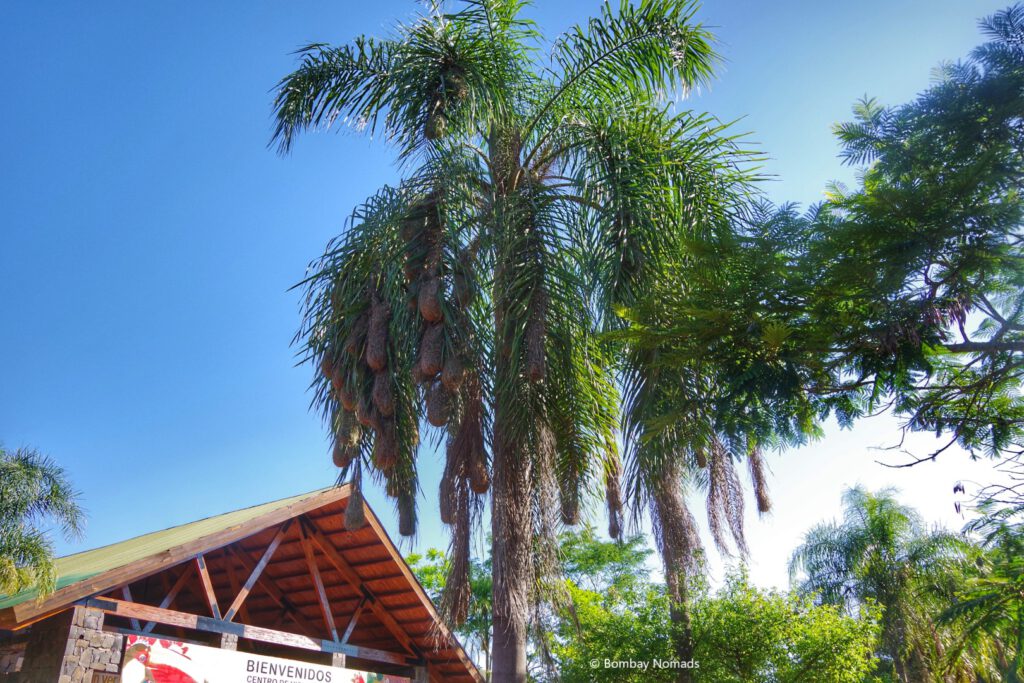
Back in our hotel, the swimming pool turned out to be quite inviting, with large shaded lounging areas. We settled down for lunch and caught up on our reading – accompanied by some cocktails.
Tip : We met an American tourist later in our travels, who said an aerial tour of Iguazu Falls on a helicopter wasn’t expensive at all. We did not do it, but it should be a marvellous way of seeing the falls.
Useful information
- Puerto Iguazu can be reached from Buenos Aires by,
- A 2 hour flight; or
- An 18 hour bus ride. Buses in Argentina (and most of South America) are very comfortable, with fully reclining seats and meal service.
- The park is open between 08:00 to 18:00 every day. You can enter till 16:30 but you will need to leave by 18:00.
- Both the entrance tickets and the boat ride tickets accepted credit cards.
- The Iguazu falls have tropical weather and there are lots of insects too. So it is highly recommended to wear sunscreen and a good quality mosquito repellent (anything which has 30% DEET or more is good) . It is good to carry them with you so that you can re-apply after a few hours, as it is quite likely you will perspire as you walk up and down. Light clothes, good walking shoes, sun glasses, a hat and water bottle are essentials.
